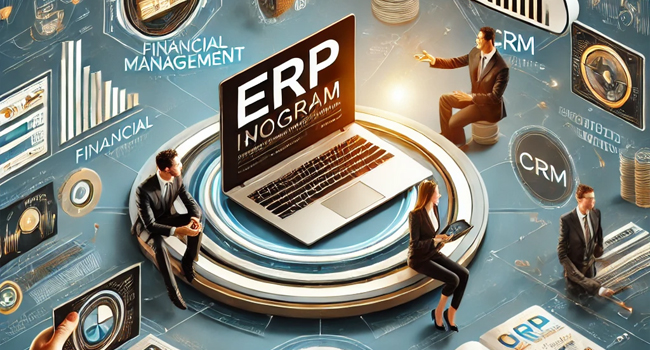Enterprise Resource Planning (ERP): Meaning, Components, and Examples
Introduction
Enterprise Resource Planning (ERP) is a crucial technology for businesses aiming to integrate and streamline operations across various departments. By utilizing ERP software, companies can enhance efficiency, improve decision-making, and ensure seamless data flow throughout the organization. This article explores the meaning of ERP, its key components, and real-world examples of ERP systems in different industries.
What is Enterprise Resource Planning (ERP)?
Definition
ERP is a centralized software system that helps businesses manage core operations, including finance, supply chain, human resources, manufacturing, and customer relations. ERP solutions integrate various business processes into a single unified system, ensuring seamless information sharing across departments.
How ERP Works
ERP software functions as a single database that collects, stores, and processes data from different departments. It eliminates redundant processes, reduces manual errors, and provides real-time insights for better decision-making.
Key Components of ERP Systems
ERP systems are made up of several core components that help businesses manage their operations effectively. Below are the key components:
1. Financial Management
ERP includes a comprehensive financial module to handle accounting, budgeting, tax compliance, and financial reporting.
| Feature | Description |
|---|---|
| General Ledger | Tracks company finances and transactions. |
| Accounts Payable & Receivable | Manages payments to vendors and receivables from customers. |
| Budgeting & Forecasting | Helps in planning future financial needs. |
| Tax Management | Ensures compliance with tax regulations. |
2. Supply Chain Management (SCM)
This component streamlines procurement, inventory management, logistics, and supplier relationships.
| Feature | Description |
|---|---|
| Inventory Management | Tracks stock levels and movement. |
| Procurement | Manages supplier contracts and purchasing. |
| Logistics & Shipping | Optimizes distribution channels. |
| Demand Planning | Forecasts demand to maintain optimal stock levels. |
3. Human Resource Management (HRM)
HRM modules help organizations manage employees, payroll, and benefits efficiently.
| Feature | Description |
|---|---|
| Employee Records | Stores employee data and work history. |
| Payroll Management | Automates salary calculations and tax deductions. |
| Recruitment & Onboarding | Helps in hiring and training new employees. |
| Performance Management | Tracks employee performance and appraisals. |
4. Customer Relationship Management (CRM)
The CRM module manages customer interactions, sales, and support services.
| Feature | Description |
|---|---|
| Sales Automation | Tracks leads, opportunities, and sales processes. |
| Customer Support | Handles inquiries and service tickets. |
| Marketing Automation | Automates email campaigns and promotions. |
| Customer Analytics | Provides insights into customer behavior. |
5. Manufacturing & Production Management
This component is vital for production planning, scheduling, and quality control in manufacturing industries.
| Feature | Description |
|---|---|
| Bill of Materials (BOM) | Lists raw materials needed for production. |
| Production Scheduling | Plans manufacturing timelines and capacity. |
| Quality Control | Ensures products meet quality standards. |
| Work Order Management | Tracks production progress and efficiency. |
6. Business Intelligence & Reporting
ERP systems provide analytical tools to help businesses make data-driven decisions.
| Feature | Description |
|---|---|
| Data Visualization | Uses dashboards and charts for easy interpretation. |
| Custom Reports | Generates business-specific reports. |
| Predictive Analytics | Uses AI to forecast trends. |
| Real-Time Monitoring | Tracks KPIs and business performance. |
Examples of ERP Systems
Different ERP systems cater to various business sizes and industries. Below are some widely used ERP solutions:
1. SAP S/4HANA
| Aspect | Details |
|---|---|
| Deployment | Cloud & On-Premise |
| Best For | Large Enterprises |
| Key Features | AI-driven insights, automation, supply chain management |
| Pricing | Custom pricing based on business needs |
2. Oracle NetSuite ERP
| Aspect | Details |
|---|---|
| Deployment | Cloud-Based |
| Best For | Growing Businesses |
| Key Features | Financial automation, eCommerce integration, CRM |
| Pricing | Custom pricing per module |
3. Microsoft Dynamics 365
| Aspect | Details |
|---|---|
| Deployment | Cloud & Hybrid |
| Best For | SMEs & Enterprises |
| Key Features | AI-driven analytics, seamless Office 365 integration |
| Pricing | Starts at $70 per user/month |
4. Odoo ERP
| Aspect | Details |
|---|---|
| Deployment | Cloud & On-Premise |
| Best For | Small to Mid-Sized Businesses |
| Key Features | Open-source, customizable modules, HR, inventory management |
| Pricing | Free community edition; paid version starts at $20/user/month |
5. Infor CloudSuite ERP
| Aspect | Details |
|---|---|
| Deployment | Cloud-Based |
| Best For | Industry-Specific Solutions |
| Key Features | AI automation, manufacturing optimization, data analytics |
| Pricing | Custom pricing |
Choosing the Right ERP System
When selecting an ERP system, businesses should consider the following:
1. Business Needs Assessment
- Identify which business functions require automation.
- Determine if a cloud or on-premise solution is needed.
2. Scalability & Integration
- Choose an ERP that grows with the company.
- Ensure compatibility with existing software and tools.
3. Budget Considerations
- Compare licensing, implementation, and maintenance costs.
- Consider hidden costs such as training and customization.
4. Ease of Use & Support
- Opt for user-friendly interfaces and dashboards.
- Evaluate the level of customer support and training offered.
Conclusion
ERP systems are essential for modern businesses aiming to optimize their operations and improve decision-making. With various ERP solutions available, companies must carefully assess their needs, budget, and scalability before choosing the right system. Whether opting for SAP S/4HANA, NetSuite, Microsoft Dynamics 365, or another ERP system, implementing the right ERP software can drive efficiency and enhance business performance.
